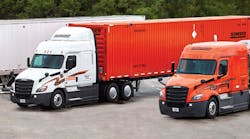On-highway vs. vocational: Both the vocational and on-highway segments saw monthly gains, but the on-highway market accounted for the majority of the year-over-year decline, according to FTR, reflecting sustained fleet caution heading into 2026.
What about 2026? Dan Moyer, FTR senior analyst, said: “Early indicators for the 2026 order cycle reinforce this cautious outlook. Combined net orders for September and October are 32% below year-ago levels, highlighting persistent weakness in freight fundamentals and limited carrier profitability. The month-over-month uptick in October likely reflects targeted replacement activity rather than renewed investment. For OEMs and suppliers, visibility remains limited, and order trends are expected to stay uneven until freight volumes and rates improve. In the meantime, fleets are focusing on cost control and asset utilization over growth, delaying a meaningful rebound in equipment demand until economic and market conditions stabilize.”
How are tariffs impacting equipment? “For the industry, the new tariffs on heavy-duty trucks that are taking effect this month will raise costs but are less severe and more targeted than expected,” Moyer said November 4. “USMCA carve-outs, offsets, and the delayed parts tariff create a measured policy that encourages reshoring and strengthens North American supply chains. Some production appears to be already shifting toward U.S. assembly, though expanding capacity will take time. Overall, the framework aims to boost U.S. manufacturing and reduce reliance on Asia while leaving room for future policy adjustments.”






